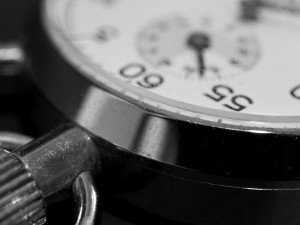Pursuing Negative-Split Marathons Can Make You Unhappy
 Pursuing negative-split marathons can make you unhappy, and I want you to be happier with your running or walking.
Pursuing negative-split marathons can make you unhappy, and I want you to be happier with your running or walking.
The concept of a negative split comes from the track world, where a “split” refers to the time required to complete a segment of an entire race or workout — for example, to complete a 400-meter lap of a 1,600-meter race. A negative split means that a subsequent segment is shorter than (faster than) a previous segment. For example, an 800-meter runner who ran the first 400 meters in 59 seconds and ran the second 400 meters in 58 seconds has run a negative-split race.
Negative splits are common in 100-meter races, given that runners start from a dead stop, shoot out of the blocks, and continue to pick up speed as they head toward the finish line. The first 50 meters are naturally slower than the second 50 meters.
Negative Splits and Longer Races
As you can imagine, the longer the race, the ability of a dead-stop start to contribute to the likelihood of a negative-split race diminishes.
So, other factors must contribute to completing a race with a negative split between the first half and the second half of the race as the race distance rises.
There is definitely something to be said for not starting a marathon too quickly. You CAN burn yourself out by running the first half too quickly, and I proved that to myself in my two most recent marathons.
Common Advice about Negative Splits
My motivation to write this article came from this training advice that I saw recently online:
We have stressed each week the importance of running your long runs practicing a negative split. We have continued to stress this because the facts will show that every world record from 1500 meters to the marathon has been set running negative splits [emphasis added] – running the first half of the race slightly slower than the second half.
Leaving the claim about shorter-than-marathon world records for others to investigate, I investigated this claim about marathon world records.
Uncommon Knowledge about Negative-Split Marathons
Let me cut to the chase:
[Tweet “Two of the last three marathon world records were set with POSITIVE splits, NOT NEGATIVE splits!”]
As of February 20, 2015, here are the details from the most recent ten marathon world records:
| Record | Runner | Marathon | Split at Half | Negative-Split Record? | ||||
| 2:02:57 | Dennis Kimetto | 2014 Berlin | 1:01:45 | Yes | ||||
| 2:03:23 | Wilson Kipsang | 2013 Berlin | 1:01:34 | No | ||||
| 2:03:38 | Patrick Makau | 2011 Berlin | 1:01:44 | No | ||||
| 2:03:59 | Haile Gebrselassie | 2008 Berlin | 1:02:05 | Yes | ||||
| 2:04:26 | Haile Gebrselassie | 2007 Berlin | 1:02:29 | Yes | ||||
| 2:04:55 | Paul Tergat | 2003 Berlin | 1:03:01 | Yes | ||||
| 2:05:38 | Khalid Khannouchi | 2002 London | Unavailable | Unknown | ||||
| 2:05:42 | Khalid Khannouchi | 1999 Chicago | 1:03:07 | Yes | ||||
| 2:06:05 | Ronaldo da Costa | 1998 Berlin | Unavailable | Unknown | ||||
| 2:06:50 | Belayneh Dinsamo | 1988 Rotterdam | Unavailable | Unknown |
If you dive into the world record set in 2014, you see:
[Tweet “Eight of the top ten males in the world-record-setting 2014 Berlin Marathon ran POSITIVE splits!”]
If you dive into the world record set in 2013, you see:
[Tweet “ALL of the top ten males in the world-record-setting 2013 Berlin Marathon ran POSITIVE splits!”]
If you dive into the world record set in 2011, you see:
[Tweet “ALL of the top ten males in the world-record-setting 2011 Berlin Marathon ran POSITIVE splits!”]
If you dive into the world record set in 2008, you see:
[Tweet “Seven of the top ten males in the world-record-setting 2008 Berlin Marathon ran POSITIVE splits!”]
If you dive into the world record set in 2007, you see:
[Tweet “Eight of the top ten males in the world-record-setting 2007 Berlin Marathon ran POSITIVE splits!”]
If you dive into the world record set in 2003, you see:
[Tweet “Eight of the top ten males in the world-record-setting 2003 Berlin Marathon ran POSITIVE splits!”]
On the other end of the table, if you dive into the world record set in 1999, you see:
[Tweet “Eight of the top ten males in the world-record-setting 1999 Chicago Marathon ran POSITIVE splits!”]
Summarizing, only 11 of 70 top-ten males across these seven world-record-setting marathons ran negative-split races.
Put another way, more than 84% of the top-ten male runners in these seven marathons ran POSITIVE splits!
And, looking at only the three most recent world-record-setting marathons,
[Tweet “>93% of the top-ten males in the last three world-record-setting marathons ran POSITIVE splits!”]
My Advice
So, while it’s true that the most recent marathon world record was set with a negative split, the odds are against even the best of the best marathoners that they will run negative-split marathons.
And, if positive-split marathons are good enough for the most elite runners, then I recommend that you drop any obsession with running a negative-split marathon … and become happier as a result!
Learn More
If you want to read an analysis of a non-world-record-setting marathon but with many more details about that race, then check out these two articles by coach Stuart Mills on his “UltraStu” blog:
- “The Negative Split – The Realisation that An Accepted Running Concept is Actually Flawed!”
- “The Negative Split Fallacy – Part 2 – The Explanation!”
Mills absolutely crushes the marathon negative-split fallacy!
What’s YOUR Experience?
What’s your experience with trying to run negative-split marathons? I’d like to know! Please leave a comment below.